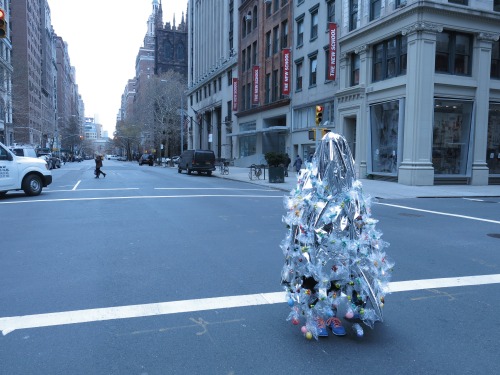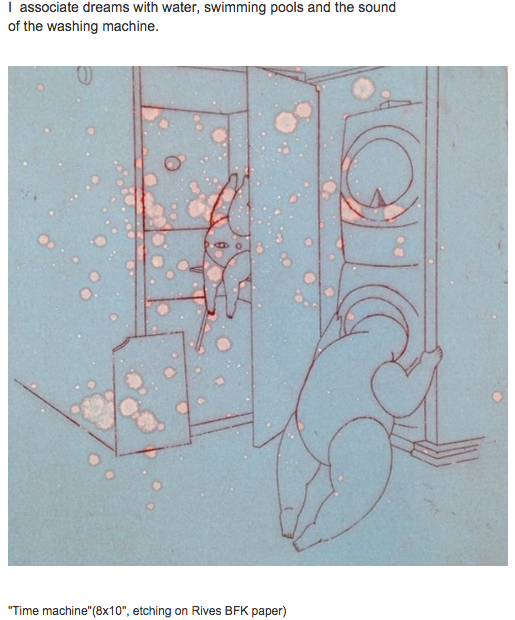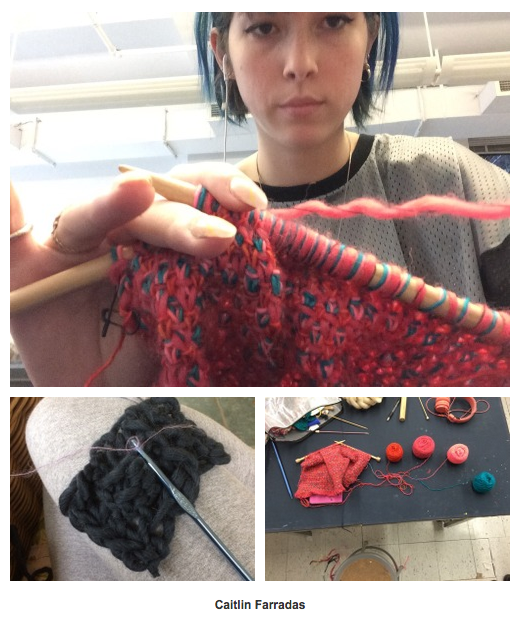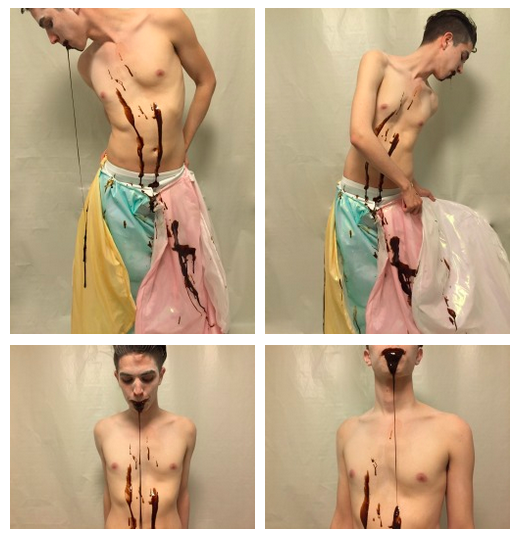We paid a visit to this class–taught by AMT Illustration faculty, Nora Krug, and School of Fashion faculty, Gabriel Asfour–sat in on some fantastic presentations, and asked a few questions.
Read on for student responses, insight from the instructor, and some amazing outfits, process shots and performances from the Fashion Illustration and Performance class and blog!
What was your project based on?
“My project was inspired by Agnes Richter’s straight jacket and Japanese Boro fabric. I was drawn to their personal, historical and durational qualities. The materials I used varied, but were mostly found objects or personal scraps discovered each day.” – Sarah Lawrence
“My project was based off my personal life being a gay man growing up in a Christian family; the idea of being trapped in a cage.” – Richard Lopez
“My Project was about Nightmares and Dreams and how could I create a portal betweeen our subconscious and our reality. I used dream catcher based elements like think rope, wire, beads, fake pearls and ostrich feathers.” – Rosa Andia
“Creating wearable objects for kids with physical disabilities.” – Lexy Ho-Tai
What was your favorite part of the class?
“Seeing other people’s work. Especially from other programs and getting their feedback.” – Xinyi Li
“Receiving feedback from both professors who have such different ideas/talents/approaches. I also enjoyed exchanging ideas with students in different majors/ disciplines.” – Sarah Lawrence
“My favorite part was the openness we were given with the assignment. We were able to allow our aesthetic to come through.” – Chrisila Maida
“The freedom and flexibility of creating our own projects.” – Carmen Gama
What has this class taught you?
“This class has taught me bigger life lessons about society and the problems that people face. This class helped me push my boundaries and develop my concept to it’s full potential.” – Advika Aggarnial
“How to follow my gut. Channel my sentimentality. Move away from writing. Achieve compelling aesthetics. Have a lot of fun!”- Anais Freitas
“This class has encouraged me to treat my work as an art form. To not hold back to make something “wearable” in ans everyday sense of the term. I have grown to trust my guy and my vision and explore it with out hesitation.” – Sarah Lawrence
“[How to combine] art with socially engaged works.” – Lexy Ho-Tai
We also asked instructor Nora Krug about the formation of the class and the development of the “Fashion Illustration Performance” blog.
How did this class and the subsequent blog come about?
I developed and taught this class last year with Pascal Gatzen, and taught it for the second time this year, together with Gabriel Asfour. This is the first year that we’ve had a blog. We thought it was important to set up a blog as a platform to not only collect and share inspirational images and visual precedents from the world of illustration, fashion and performance, but also to make sure that students kept each other updated on the development of their pieces, and their thinking and making process. Two of our students volunteered to set up the blog, and Gabriel and I kept on reminding the students to regularly upload and tag their work.
Are there any themes/restrictions that the students abide by during the semester?
There were no restrictions. We wanted to give the students as much freedom as possible, which would allow them to explore non-traditional and unconventional approaches and consider the relationship between art and society, and fashion, illustration and performance from a new angle. Bringing together students from different disciplines and having them collaborate and exchange ideas in the classroom was crucial in this approach. We encouraged students to think of the design process as a sculptural process, and to look at their pieces not as garments, but rather as art projects that, hopefully, will challenge common contemporary perceptions of how we look at the media of fashion and illustration. We urged illustration students to think beyond the flat surface and consider how wearable drawings can transform the experience of moving in a public environment, and fashion students to move away from a more commercially-driven approach and think about how garments can work as canvasses for personal expression. The only things we asked of the students was to choose themes that are of importance to them as human beings, to experiment, to share their work-in-progress on a weekly basis, to produce work consistently throughout the semester, and to deliver a fully executed final project in the end.


What are your ultimate goals for the blog and performances?
The goal of the blog was to create a platform to not only share inspirational images and visual precedents from the world of illustration, fashion and performance, but also to make sure that students kept each other updated on the development of their pieces, and their thinking and making process. Also, we wanted to be able to share what was created with the larger community at Parsons, and the general public.
We didn’t have a particular expectation of how the term “performance” should be applied. Not every student interpreted the performative aspect as engaging in a publicly staged event. For one student, the performative aspect of her project meant wearing her garment in a secluded environment, which was her own room. For another student, it meant creating tools that would help disabled teenagers engage in painting activities, and thus creating their own artistic performances. We wanted to keep the term “performance” as loose as possible.
How does this class influence the students?



